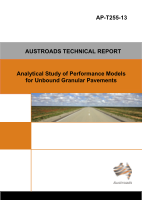Pavement

- Publication no: AP-T255-13
- ISBN: 978-1-925037-30-2
- Published: 21 November 2013
- PDF (free) Download
This report presents an analytical and parametric study to assess the relevance of rutting performance models for unbound granular pavements.
The rutting performance relationship used in the Austroads Guide to Pavement Technology Part 2 – Pavement structural designdoes not take into account the performance of each granular layer and the subgrade and globalises the whole pavement deformation. The deformation of the base layer can significantly contribute to the total pavement deformation and is not evaluated separately from material performance parameters. A new performance based framework for rutting prediction allowing model calibration on wheel-tracking tests and pavement prediction has been built.
The reports presents a validation of the calibration stage from experimental data obtained with the new wheel-tracker developed for unbound granular materials. For simple pavement configurations, the base deformations are calculated and highlight the difficulties in extrapolating laboratory to pavement performances. The model is used to calculate the relative performance factors obtained for changes in base thickness, subgrade stiffness and axle mass. The parametric analyses conclude consistency of the trends obtained when the pavement configuration and loading are modified and support further development toward validation.
In the future the Austroads project TT1819 will provide the data available to validate the framework approach for road base deformation modelling.
- 1. Introduction
- 1.1. Project Background
- 1.2. Report Outline
- 2. The Permanent Deformation Relationships
- 2.1. Permanent Deformation with Respect to the Loading Stresses
- 2.1.1. Empirical Mathematical Function
- 2.1.2. Stress Analysis in the Wheel-tracking Slab
- 2.1.3. Influence of the Parameters in the Wheel-tracking Slab
- 2.2. Permanent Deformation with Respect to the Loading Cycles
- 2.3. Performance Relationship Selected for Investigation
- 3. Calibration of the material model Using wheel-tracking data
- 3.1. Wheel-tracking Data used for Model Fitting
- 3.2. Wheel-tracking 3D Finite Element Model
- 3.2.1. Wheel-induced Contact Stresses
- 3.2.2. Resilient Properties
- 3.2.3. Results from the Stress Analysis
- 3.3. Model Calibration on Wheel-tracking Data
- 3.3.1. Relationship A
- 3.3.2. Relationship B
- 3.4. Conclusion
- 4. Pavement Deformation prediction
- 4.1. Pavement Deformation Prediction using Relationship A
- 4.2. Pavement Deformation Prediction using Relationship B
- 4.3. Analysis of the Predicted Pavement Deformation
- 4.4. Modelling Conditions
- 5. Permanent Model sensitivity to Changes in Pavement Configurations and Loading
- 5.1. Relative Deformation Ratio
- 5.1.1. Influence of the Base Thickness
- 5.1.2. Influence of the Subgrade Stiffness
- 5.2. Effect of Axle Load Increase
- 5.2.1. Previous Data on the Effect of Axle Load Increase
- 5.2.2. Modelling the Axle Load
- 5.2.3. Calculated Relative Deformation Ratio
- 5.3. Summarising the Impact of Modelling Conditions on Deformation Prediction
- 6. Conclusions
- References
- Appendix A Material model Used for unbound granular materials
- A.1 Nonlinear Elastic Model
- A.2 Presumptive Values for Base and Subbase Materials
- Appendix B Integration of the permanent deformation with depth
- B.1 Integration Approach for the Wheel-tracker Slab
- B.2 Integration Approach for a Pavement Base Layer
- Appendix C Calibration results
- C.1 Relationship A
- C.2 Relationship B
